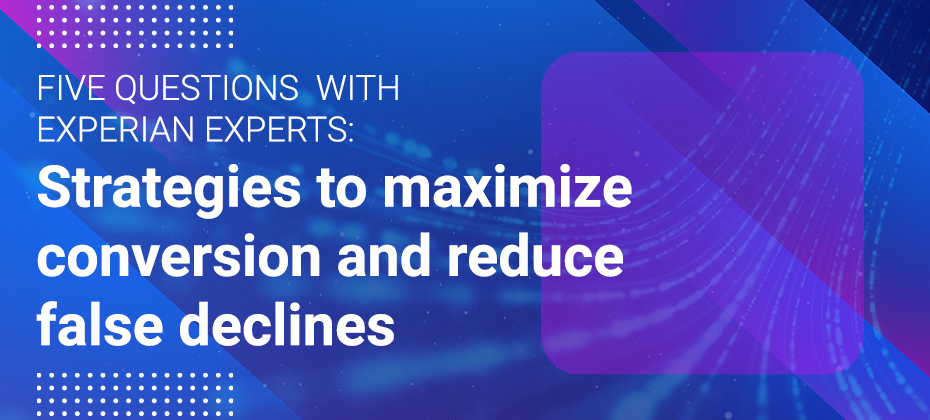Tag: credit card

Online fraud has increased exponentially over the past few years, with the Federal Trade Commission (FTC) data showing that consumers reported losing more than $10 billion to fraud in 2023. This marks the first time that fraud losses have reached that benchmark, and it’s a 14% increase over reported losses in 2022. As a result, e-commerce merchants and retailers have reacted by adding friction to e-commerce interactions. The risk is that a legitimate user may be denied a purchase because they have incorrectly been labeled a fraudster — a “false decline.” Now, as the holiday shopping season approaches, e-commerce merchants expect a surge in online spending and transactions, which in turn creates concern for an uptick in false declines. In a recent webinar, Experian experts Senior Vice President of Business Development and eCommerce Dave Tiezzi and Senior Director of Product Management Jose Pallares explored strategies for how e-commerce merchants can determine the risk level of a transaction and ensure that they do not miss out on genuine purchases and good customers. Below are a few key perspectives from our speakers: What are the biggest challenges posed by online card transactions? DT: One of the biggest issues merchants face is false declines. In the report, The E-Commerce Fraud Enigma: The Quest to Maximize Revenue While Minimizing Fraud Experian and Aite-Novarica Group (now Datos Insights) found that 1.16% of all sales are unnecessarily rejected by merchants. While this percentage may seem small, it represents significant revenue loss during the high-volume holiday shopping season. The report also highlights that 16% of all attempted online transactions encounter some form of friction due to suspected fraud. Alarmingly, 70% of that friction is unnecessary, meaning it’s not preventing fraud but instead disrupting the purchasing process for legitimate customers. This friction translates into a poor online shopping experience, often resulting in cart abandonment, lost sales and a decline in customer loyalty. What are the key consumer trends and expectations for the upcoming holiday season? DT: Experian's 2024 Holiday Spending Trends and Insights Report reveals that while 35% of holiday shopping in 2023 occurred in December, peaking at 9% the week before Christmas, Cyber Week in November also represented 8% of total holiday sales. This highlights the importance for merchants to be prepared well before the holiday rush begins in November and extends through December. As they gear up for this high-volume season, merchants must also prioritize meeting consumer expectations for speed, ease and security—which are top-of-mind for consumers. According to our 2024 U.S. Identity & Fraud Report, 63% of consumers consider it extremely or very important for businesses to recognize them online, while 81% say they’re more trusting of businesses that can accomplish easy and accurate identification. They’re also wary of fraud, ranking identity theft (84%) and stolen credit card information (80%) as their top online security concerns. Considering these trends, it’s important for merchants to ensure seamless and secure transactions this holiday season. False declines are a persistent problem for e-commerce merchants, especially during the holidays. How can merchants minimize these declines while protecting consumers from fraud? What best practices can merchants adopt to address these risks? JP: False declines often result from overly cautious fraud detection systems that flag legitimate transactions as suspicious. While it’s essential to prevent fraud, turning away legitimate customers can severely impact both revenue and customer satisfaction. To minimize false declines, merchants should leverage advanced fraud prevention tools that combine multiple data points and behavioral insights. This approach goes beyond basic fraud detection by using attributes such as customer behavior, transaction patterns and real-time data analysis. Solutions incorporating NeuroID’s behavioral analytics and signals can also better assess whether a transaction is genuine based on the user’s interaction patterns, helping merchants filter out bad actors and make more informed decisions without disrupting the customer experience. What actionable strategies should e-commerce brands or merchants implement now to reduce cart abandonment and ensure a successful holiday season? JP: One of the most effective tools we offer is Experian Link™, a credit card owner verification solution designed to reduce false declines while protecting against fraud. Experian Link helps e-commerce merchants and additional retailers accurately assess transaction risk by answering a key question: Does this consumer own the credit card they presented for payment? This ensures that legitimate customers aren’t mistakenly turned away while suspicious transactions are properly flagged for further review. By adopting a multilayered identity and fraud prevention strategy, merchants can significantly reduce false declines, offer a frictionless checkout experience and maintain robust fraud defenses—all of which are essential for a successful holiday shopping season. Are there any examples of a retailer successfully leveraging credit card owner verification solutions? What were the results? JP: Yes. We recently partnered with a leading U.S. retailer with a significant online presence. Their primary goals were to reduce customer friction, increase conversion and identify their customers accurately. By leveraging Experian Link and its positive signals, the retailer could refine, test and optimize their auto-approval strategies. As a result, the retailer saw an additional $8 million in monthly revenue from transactions that would have otherwise been declined. They also achieved a 10% increase in auto-approvals, reducing operating expenses and customer friction. By streamlining backend processes, they delivered a more seamless shopping experience for their customers. Stay ahead this holiday season For more expert insights on boosting conversions and enhancing customer loyalty, watch our on-demand webinar, Friction-Free Festivities: Strategies to Maximize Conversion and Reduce False Declines, hosted by the Merchant Risk Council (MRC). Additionally, visit us online to learn more about how Experian Link can transform your business strategy. Watch on-demand webinar Visit us The webinar is available to MRC members. If you’re already a member, you can access this resource here. Not a member? Our team would be happy to schedule a demo on Experian Link and discuss strategies to help your business grow. Get in touch today.

This article was updated on August 24, 2023. The continuous shift to digital has made a tremendous impact on consumer preferences and behaviors, with 81% thinking more highly of brands that offer multiple digital touchpoints. As a result, major credit card issuers are making creative pivots to their credit marketing strategies, from amplifying digital features in their card positioning to promoting partnerships and incentives on digital channels. But as effective as it is to reach consumers where they most frequent, credit card marketing will need to be more customer-centric to truly captivate and motivate audiences to engage. So, what does this innovative period of credit marketing mean for financial institutions? How can these institutions stand out in a competitive, ever-changing market? To target and acquire the right consumers, here are three credit card marketing strategies financial institutions should consider: Maximize share of voice through targeted approaches About half of consumers say personalization is the most important aspect of their online experience. Because today’s consumers are now expecting to engage digitally with brands, it’s important for financial institutions to not only be seen and mentioned on the right digital channels, but to deliver content that will resonate with their specific audiences. To do this, lenders must leverage fresh, comprehensive data sets to gain a more holistic view of consumers. This way, they can create targeted, customer-centric prescreen campaigns, allowing for enhanced personalization and increased response rates. Seek new opportunities to provide value to customers 77% of Gen Zers believe having an established credit history is important to being less financially dependent on their parents. Changes in consumer needs and lifestyles provide great opportunities to deliver value to customers. For example, younger consumers starting their credit journeys may look for brands that offer financial education or tools to help them build credit. Financial institutions that are open to pivoting their strategies to adapt to these needs and behaviors are those that will succeed in attracting new customers and maintaining long-lasting relationships with existing ones. Amplify points of differentiation in their products and marketing Before buying a product, consumers likely want to know more about the items they are purchasing and how they compare to different players in the market. To help set their products apart from other offerings, financial institutions should clearly define their product’s key differentiators and convey them in a personalized and compelling manner. Enhance your credit card marketing campaigns From identifying the right prospects to saturating your targeting criteria with data-rich insights, Experian offers credit marketing solutions to help you level up your campaigns and stand out from the competition. Learn more

With nearly seven billion credit card and personal loan acquisition mailers sent out last year, consumers are persistently targeted with pre-approved offers, making it critical for credit unions to deliver the right offer to the right person, at the right time. How WSECU is enhancing the lending experience As the second-largest credit union in the state of Washington, Washington State Employees Credit Union (WSECU) wanted to digitalize their credit decisioning and prequalification process through their new online banking platform, while also providing members with their individual, real-time credit score. WSECU implemented an instant credit decisioning solution delivered via Experian’s Decisioning as a ServiceSM environment, an integrated decisioning system that provides clients with access to data, attributes, scores and analytics to improve decisioning across the customer life cycle. Streamlined processes lead to upsurge in revenue growth Within three months of leveraging Experian’s solution, WSECU saw more members beginning their lending journey through a digital channel than ever before, leading to a 25% increase in loan and credit applications. Additionally, member satisfaction increased with 90% of members finding the simplified process to be more efficient and requiring “low effort.” Read our case study for more insight on using our digital credit solutions to: Prequalify members in real-time at point of contact Match members to the right loan products Increase qualification, approval and take rates Lower operational and manual review costs Read case study

Even as 75% of large and mid-sized U.S. e-commerce marketplace merchants predict continued double-digit online sales growth rates through the end of 2022,1 their success is hampered by unnecessary friction driven by concerns of card-not-present fraud and additional fraud risks in an online world. Compared to the 96% approval rate for point-of-sale purchases, card-not-present transactions yield a surprisingly low 81% approval rate. According to a survey conducted by Aite Novarica,1 the difference stems from reviewing up to 16% of attempted transactions for possible fraud. Even more surprising is that many of the respondents report that more than two-thirds of these reviews are later found to be unwarranted. Current transaction processing and risk capabilities are impeding growth and creating friction that damages e-commerce marketplace brands. What do we mean when we talk about online card-not-present transaction friction? Much of the success or failure of e-commerce depends on how easy merchants make it for consumers to complete a transaction. Effective identity resolution, fraud mitigation and risk solutions can lead to increased sales, while unrefined solutions and unnecessary friction will run merchants the risk of denying a legitimate customer purchase at checkout because they have been incorrectly labeled a fraudster–a ‘false positive’ or ‘false decline.’ These solutions leave room for improvement based on several key factors–the limited amount of data that passes through the authorization stream from the merchant to the issuer is a key contributor. According to Aite-Novarica Group’s The E-Commerce Fraud Enigma: The Quest to Maximize Revenue While Minimizing Fraud Report, “This reinforces the importance for merchants to augment the decisioning on their side with a wide variety of data sources that can help inform them regarding the risk profile of both the customer and the transaction.” Challenges with current transaction processing and verification tools Today, merchants leverage email address data, device information and other technologies to augment their address verification capabilities. The challenge is that these tools each judge the risk of a specific component of the transaction or the individual. Where integration is lacking, false positives are amplified and that is exactly what the data1 says is happening. Different tools working in isolation all catch the same fraud but flag different false positives—dragging down overall performance. The result is that 75% of e-commerce merchants place maximizing sales, minimizing friction and reducing false declines at the top of their to-do list. 88% say they are ready for a change to achieve these goals.1 Fast Facts 16% of all attempted online transactions experience friction for suspected fraud. 70% of this number is unnecessary, and upon manual review, are ultimately approved.1 78% of e-commerce merchants report friction driven by suspected fraud is increasing. 78% of merchants report increasing declines due to suspected fraud over the last two years. 46% indicate an increase of more than 5%.1 81% of consumers say that a positive online experience makes them think more highly of a brand.2 The longer it takes for banks and issuers to process new account, the higher the rate of abandonment, which reaches 40% when the process takes longer than 10 minutes.3 The friction that consumers encounter throughout their buying journey and the expenses associated with merchant and issuer manual reviews can be costly. It is estimated that 70% of unwarranted friction is costing businesses ~$11B in false decline losses and sales annually.1 That number is expected to increase. And, beyond profit losses incurred from the order that was declined, merchants risk damaging brand reputation because of poor customer/buying experiences, and in some cases, the loss of the customer relationship as well. Reducing friction and providing a positive shopping experience is increasingly important to business success Businesses looking to address this and limit false declines should not allow this to come at the expense completing transactions for legitimate customers. Experian can help. By leveraging our multidimensional data, technical expertise and advanced analytics capabilities, we can help businesses authenticate valid customers without unnecessary friction, thus increasing revenue by increased approval rates, without increasing fraud or operating expenses. Get started with Experian Link™ - our frictionless credit card owner verification solution. Learn more. Experian Link 1"E-Commerece Fraud Enigma: The Quest to Maximize Revenue While Minimizing Fraud Report" Aite-Novarica Group, July 2022 2"Global Insights Report: The Evolving Expectations and Experience of the New Digital Customer" Experian, April 2022 3"Capturing the Digital Identity Evolution Through a Layered Approach" Liminal, June 2021

From awarding bonus points on food delivery purchases to incorporating social media into their marketing efforts, credit card issuers have leveled up their acquisition strategies to attract and resonate with today’s consumers. But as appealing as these rewards may seem, many consumers are choosing not to own a credit card because of their inability to qualify for one. As card issuers go head-to-head in the battle to reach and connect with new consumers, they must implement more inclusive lending strategies to not only extend credit to underserved communities, but also grow their customer base. Here’s how card issuers can stay ahead: Reach: Look beyond the traditional credit scoring system With limited or no credit history, credit invisibles are often overlooked by lenders who rely solely on traditional credit information to determine applicants’ creditworthiness. This makes it difficult for credit invisibles to obtain financial products and services such as a credit card. However, not all credit invisibles are high-risk consumers and not every activity that could demonstrate their financial stability is captured by traditional data and scores. To better evaluate an applicant’s creditworthiness, lenders can leverage expanded data sources, such as an individual’s cash flow or bank account activity, as an additional lens into their financial health. With deeper insights into consumers’ banking behaviors, card issuers can more accurately assess their ability to pay and help historically disadvantaged populations increase their chances of approval. Not only will this empower underserved consumers to achieve their financial goals, but it provides card issuers with an opportunity to expand their customer base and improve profitability. Connect: Become a financial educator and advocate Credit card issuers looking to build lifelong relationships with new-to-credit consumers can do so by becoming their financial educator and mentor. Many new-to-credit consumers, such as Generation Z, are anxious about their finances but are interested in becoming financially literate. To help increase their credit understanding, card issuers can provide consumers with credit education tools and resources, such as infographics or ‘how-to’ guides, in their marketing campaigns. By learning about the basics and importance of credit, including what a credit score is and how to improve it, consumers can make smarter financial decisions, boost their creditworthiness, and stay loyal to the brand as they navigate their financial journeys. Accessing credit is a huge obstacle for consumers with limited or no credit history, but it doesn’t have to be. By leveraging expanded data sources and offering credit education to consumers, credit card issuers can approve more creditworthy applicants and unlock barriers to financial well-being. Visit us to learn about how Experian is helping businesses grow their portfolios and drive financial inclusion. Visit us

Rewards are among the most appealing features of any credit card. While upfront benefits, like sign-up bonuses and cashback, are most influential in card acquisition, ancillary benefits, like fraud and identity protection, can amplify a card’s overall value.1 Credit card fraud ranked as the second most common form of identity theft in 2021,2 and is expected to become even more frequent as consumers continue to bank and shop online.3 42% of consumers are concerned for the safety of their banking and shopping transactions. With digital identity theft and fraud on the rise, it’s no surprise that safety measures are “very” or “extremely” important to consumers when deciding between different credit cards.4 In response, many card issuers have started to market their security and protection-related benefits more frequently to better capitalize on their cards’ value to consumers. The ways they’ve highlighted these benefits include: A fraud protection campaign From spotlighting their fraud protection benefits in card welcome kits to providing privacy tips on social media, credit card issuers have crafted compelling campaigns to demonstrate their commitment to protecting their customers from fraud and identity theft. In turn, issuers can differentiate their cards from the competition and improve response rates. Reminders about their fraud prevention efforts Issuers have also sent out ongoing reminders outlining the protections their credit cards offer, such as credit monitoring services 5 that notify cardholders of suspicious activity on their credit report. By consistently promoting their efforts to keep their customers’ accounts and data safe, issuers can earn their cardholders’ trust, build loyalty and drive card usage. While benefits like cashback and travel points can help with card acquisition, fraud and identity protection benefits can help drive long-term customer relationships, especially now that card fraud is becoming a growing concern.6 To learn more about how businesses have worked to meet the consumer demand for secure interactions, check out our 2021 Global Identity and Fraud Report. Learn more 1Jonathan O'Connor. "Most Consumers Aren't Aware of Their Credit Cards' Ancillary Benefits. How Does This Impact Card Acquisition and Usage?" TSYS, January 2019 2FTC. "Consumer Sentinel Network" Data Book, 2021 3April Berthene. "Coronavirus pandemic adds $219 billion to US ecommerce sales in 2020-2021" Digital Commerce 360, March 2022 4"Consumers Consider as Many as Six Factors When Choosing Credit Card" PYMTS.com, December 2021 5David McMillin. "Identity theft is a major problem, but these 5 credit card protection programs can help keep you safe" Business Insider, June 2021 6"New FICO Survey Finds Overconfidence Could Put US Consumers at Risk From Scams" Business Wire, February 2022

With consumers having more banking options than ever before, loyalty has become the most valuable currency for financial institutions (FI). As fintechs and big tech companies continue to roll out innovative banking and payment options, traditional FIs must rethink their strategies to drive new business, retain existing customers and remain competitive. According to a recent Mintel report, rewards, transparency and customer service are the top three constants when it comes to building loyalty. Here’s how financial institutions can deliver on these fronts to create and maintain lasting customer relationships: Rewards programs and incentives Rewards have long been a key customer retention strategy, with 39% of consumers stating they would remain loyal to their financial service providers if they offered incentives and rewards. While traditional rewards programs that offer points or cash back on everyday purchases remain popular, many companies are expanding beyond the conventional rewards structure to attract new customers and stand out from the competition. For example, one California-based startup enables its cardholders to earn points at every winery, wine club or wine shop, while a health and wellness company rewards its cardholders with extra cash back when they meet their weekly fitness goals. To build and maintain customer loyalty, FIs can follow suit by incentivizing positive financial behavior, such as offering points to customers when their credit score increases or when they reach their monthly savings goal. Being rewarded for improving their financial health can encourage customers to continue making positive and responsible financial decisions. When customers see how much their financial institution invests in their financial well-being, they are more likely to remain loyal to the brand. Nurturing existing customers through rewards programs is also more cost-effective than acquiring new ones. Rewards program members spend 5-20% more than non-members on average, which not only covers operating costs but leads to increased sales and revenue. Transparency over fees Beyond rewards programs and incentives, many FIs have created innovative tools to help customers avoid overdraft fees, such as real-time alerts for low balances. To take it a step further, some have eliminated these fees altogether. While overdraft fees can be an easy source of revenue for financial institutions, they are a pain point for customers, especially for those who are financially vulnerable. Rather than continuing to be saddled with hefty penalties, customers are likely to switch to providers that are more upfront about their fees or have eliminated them outright. To avoid losing current and prospective customers to new competition, FIs need to be more transparent and work toward establishing fairer practices. Quick, friendly, and accessible customer service With today’s consumers having increased expectations for easy, convenient and accessible customer service, many FIs have refined their strategies by becoming digital-first. When customers have a question or concern, they can engage with financial institutions at any time through digital channels, including chat, email or social media. Being accessible at any hour of the day to assist their customers provides FIs with a great opportunity to build trust, loyalty and a positive reputation. By providing exceptional customer service, compelling rewards and being transparent, financial institutions have the power to create long-lasting customer relationships. Learn more about what you can do to retain your best customers or check out how to build lifetime loyalty with Gen Z. Learn more Build loyalty with Gen Z

The payments landscape is rapidly evolving, and as businesses set their strategic agendas for the new year, it’s important to analyze and adapt to changing consumer payment behaviors. Here are a few payment trends to look out for: Consumer sentiment remains low while inflation hits 39-year high According to the University of Michigan’s latest consumer sentiment survey, sentiment rose to 70.4 in December 2021 from 67.4 in November. While this was a slight improvement from the 10-year low logged in November, the figure was roughly in line with the average reading of the past four months (70.6). Additionally, consumer prices increased 6.8% over the past year, the highest in nearly 40 years. When asked whether inflation or unemployment was the more serious problem facing the nation, 76% of survey respondents selected inflation while 21% selected unemployment. Rising prices and the uncertainty surrounding the Delta and Omicron variants may cause consumers to remain pessimistic about their personal financial progress and delay large purchases. Payment preferences vary by age and purchase type According to a recent Mintel report, credit cards are the most preferred method of payment among U.S. adults. Despite the overall preference for credit cards, attitudes toward this payment option differ based on consumer age. Credit card preference skews strongly toward older consumers, with 46% of Baby Boomers opting to use credit cards for most of their purchases and 72% of the World War II generation preferring credit cards to any other payment type. Conversely, younger generations are turning to cash, debit cards and digital payment alternatives for most of their purchases. This difference can be explained by younger consumers’ fear of debt and lack of credit education. While older consumers may feel more comfortable and capable of paying off their credit card bill each month, most Gen Z consumers are not creditworthy enough to own a credit card or are afraid of falling behind on their monthly payments. Though Gen Z’s low ownership rate may seem concerning to credit card issuers, there’s an enormous opportunity for them to reach and engage this younger cohort. By educating younger consumers about their products and the importance of building credit, credit card issuers can build lasting customer relationships and maintain their standing in the payments hierarchy. Payment preferences also vary by purchase type. Consumers mostly use debit cards and credit cards for in-store purchases, while direct payments from bank accounts are used to pay off recurring bills. Despite these preferences for card and online payments, cash remains a popular secondary payment method across age demographics. Older consumers use cash to make small, personal transactions, while younger consumers are more likely to use cash or debit cards for large purchases. Digital payment popularity continues to soar From 2019 to 2020, peer-to-peer payment (P2P) services, like Venmo, Zelle and Cash App, saw usage increases of 2 to 3 percentage points. In 2021, that year-over-year increase jumped to 8, 9 and 7 percentage points respectively. This jump indicates that while consumers may have been reluctant to adjust their payment behaviors at the beginning of the pandemic, ongoing social distancing measures forced them to adapt to a new reality, leading to the widespread adoption of digital payment methods. As consumers continue to embrace P2P services, traditional payment powerhouses must pivot their strategies to capitalize on this trend and remain competitive in today’s payments landscape. To keep up with the latest consumer and economic trends, register for our upcoming Monthly Credit and Economic Trends webinar.

Who said that direct mail was dead? Though consumers have flooded to digital channels since the onset of the pandemic, with 55% now having a higher expectation of their customer experience, traditional methods shouldn't be cast aside. On the other hand, sending printed mail without adapting to consumer demands may leave recipients disengaged and less likely to act. So, where does that leave marketers? How can businesses create a balance between traditional and digital credit marketing? Before diving into that discussion, it’s important to note that direct mail is still effective and when done right, can help businesses win the hearts and wallets of today’s consumers. According to the U.S. Postal Service’s (USPS) Certified Direct Mail Professional (CDMP) program, 79% of households say they read their daily mail, while 70% of recipients are curious to find out what’s in their mailbox. So, how can credit card marketers capitalize on these trends to generate higher response rates and returns from their direct mail campaigns? It’s simple – businesses must weave interactive elements and technology into their direct mail pieces to make them more effective and engaging. Here’s how credit card issuers are leveraging technology to level up their direct mail campaigns: QR codes QR codes, which allow consumers to read restaurant menus and make touchless payments with their mobile devices, have become a global sensation, with the number of interactions having grown 94% between 2018-2020. More recently, credit card marketers have included interactive QR codes into their direct mail pieces, allowing recipients to learn more about the offer, download their mobile app or quickly apply for a credit card. A few brands took it a step further by matching their QR codes with the colors of their logos to add more brand recognition and personalization. Voice Activated Call to Action (VACTA) According to Mintel, over 25% of U.S. adults own at least one smart speaker. To capitalize on this trend, many credit card issuers have included a Voice Activated Call to Action (VACTA) in their direct mail pieces. A VACTA allows recipients to respond to direct mail offers verbally by using their Amazon Alexa or Google Assistant device. Instead of reaching for their smartphones or laptops, consumers can call out to their smart speaker with the offer code. This low-effort, hands-free method is a quick and convenient way for consumers to engage with businesses as it enables them to respond to offers even when they are performing other tasks. Once their smart speaker receives the code, a link is then sent to the consumer’s phone so that they can examine the offer at any time. Giving consumers more flexibility enhances their experience and increases the chances of them responding to future offers. Additionally, including a VACTA in direct mail pieces allows marketers to manage, track and optimize their marketing campaigns in real-time. Because VACTAs make offers immediately redeemable, businesses can easily measure the performance and effectiveness of each direct mail piece. Informed Delivery emails What better way to build anticipation and excitement for direct mail offers than to give consumers a sneak peek of what’s to come? USPS’s Informed Delivery is a service that allows consumers to digitally preview their direct mail before it arrives in their physical mailbox. Until the physical mail piece is delivered, consumers can look at what the mailing might reveal or offer to them through email, an online dashboard or a mobile app. The best part? Informed Delivery emails meet today’s consumer expectations for convenient digital experiences as they are available to view them anytime, anywhere. Currently, one in five households has an Informed Delivery participant. What’s more, the average open rate for an Informed Delivery email is nearly 70%. By incorporating Informed Delivery into direct mail campaigns, businesses can generate additional impressions, improve customer engagement and drive more conversions. Doing direct mail, the right way Direct mail isn’t outdated, antique or ineffective – it has evolved and adapted to meet the expectations of today’s consumers. The use of QR codes, VACTA and USPS Informed Delivery, are just a few examples of how credit card marketers are leveraging digital enhancements to improve the success of their direct mail campaigns. While it’s clear that direct mail is still an effective way to reach consumers, businesses should not overlook the power of digital marketing. Expectations for seamless and connected digital experiences are higher than ever, making it crucial for businesses to develop strong digital marketing strategies. By engaging with consumers in the way that works best for them, with the right messages at the right time, you can drive more opportunities, reduce costs and deliver exceptional customer experiences. Learn more Download white paper

When I worked as a junior analyst for one of the largest credit card issuers in the United States, the chief credit risk officer required the development of a “light switch report” and strongly encouraged everyone in her organization to read the report every day. She called it the light switch report because every morning when she walks into her office and the lights switch on, she would read the report and understand what’s going on with the business. I took her advice and developed the habit of reading the light switch report every morning — for more than a decade while I was with the organization. I knew the volume of applications, the approval rate and the average line of credit of approvals. I developed an informed idea of how delinquency rates would look six months into the future based on the average credit score of approvals today. Her advice was valuable, and the discipline she shared helped me develop my skill sets as a junior analyst, a people manager and head of a retail business line. Performance reports are foundational and are one of the key elements of a sound and prudent risk management framework. Regulators require effective monitoring reports and provide guidance on report generation as part of its examination process. (Office of the Comptroller of the Currency. Comptroller’s Handbook, Retail Lending Safety and Soundness. April 2017. Page 15.) While supporting lender clients on strategy designs and development, I have an opportunity to review various performance reports. I’d like to take this time to reiterate some of the basic components of a good performance report. Knowledge of audience is primary. Good performance reports are tailored for specific audiences who can make decisions that will affect specific outcomes. Performance reports for day-to-day monitoring would be different from reports designed for executive leadership. Transparency and accuracy are required and when reports are designed in support of areas of responsibility, those reports become meaningful and transformative. Relevant metrics matter. Once you identify the report’s audience, the metrics you choose to appear in the report become the next important exercise. Metrics should be relevant and consistent with the audience who’s expected, upon reviewing the report, to make statements such as the business is doing well and stable, or corrective action is needed. For example, a report on the predictive power of credit risk scores intended for model developers will likely contain metrics such Kolmogorov-Smirnov (KS), Gini index or worst scoring capture rate. Such reports won’t include the average handling time of an application, which will be more appropriate for an operations team. Metrics become even more powerful for decision-makers when calculated at a segment level. I’m a big fan of vintage reports. They tell the story of current lending practices (e.g., approval rates, average loan amount, average booked credit risk score), and more significantly they often foretell future performance (e.g., delinquency rates, charge-off rates). These foresights allow analysts and managers to plan and develop strategies today to manage the future state. If approve or decline decisions use a dual score matrix, generate a report showing the volume of applications on the dual score matrix. It’s quicker to spot unusual distributions compared to expectations when data is presented at this sublevel. The benefit is swifter modification or new actions when needed. If statistical designs are utilized, such as test or control segments and champion or challenger segments, metrics calculated at these levels become insightful. They allow validation of a randomized process and support statistical analysis and statements. Timeliness of reports is critical. Some reports for operational or technology purposes require constant and continuous reporting. Daily reports are important especially when new strategies are implemented. Sometimes daily reports are far more relevant within the first two or three weeks of a new strategy implementation. When daily reports show stabilization and alignment to expectations, switching to weekly or monthly reports is acceptable. Most retail products are designed for review on a cycle or monthly basis. Monthly and quarterly reports are milestones and provide good health checks of the business. Don’t forget formats. If a picture is worth a thousand words, then use charts and graphs to display data and capture audience attention. We’re all used to seeing data presented in tables, but there are far more applications today that allow us to read reports with compelling graphics, trendlines and patterns that grab our curiosity and draw us into the story. I like narratives even if they appear as headlines on a report. Succinct comments show discipline and convey understanding of a report’s contents. Effective performance reports evolve as the business changes. Audience, metrics and segments will change, but the basic components provide general guidelines on developing consistent and relevant reports.

Inactive credit card accounts are defined as credit cards that were approved, opened and never used by account holders. They also include credit card accounts that were approved, opened, utilized by account holders but don’t have a balance for the last six to 12 months. Inactive credit card accounts pose several challenges and opportunities to lenders. A review of inactivity rates of credit card portfolios of credit unions across the United States as of March 2018 shows that inactive accounts comprise approximately 11 percent of total accounts on the books. The average credit line of inactive accounts is $8,700. (Data were extracted from Experian’s File One™ database using a sample of credit card accounts with credit unions across the United States as of March 2018. Sample size is approximately 600,000 credit card accounts.) Why do credit card accounts become inactive? One potential reason for inactivity is the convenience of securing a credit card during demand deposit account (“DDA”) opening processes. Lenders today may prequalify or preselect a customer quickly and efficiently for a credit card while a customer’s request to open a checking account or deposit account is being processed. Lenders benefit from this choreographed process with no to very minimal additional effort and time requested from the customer. The removal or significant decrease in friction costs — such as requiring additional customer information that previously would have deterred a customer from proceeding with the credit card application — gave lenders the advantage of processing more applications. (Schruder, Kyle. Feb. 26, 2018. The Top 5 Behavioural Economics Principles for Designers — Bridgeable blog. https://uxplanet.org/the-top-5-behavioural-economics-principles-for-designers-ea22a16a4020.) Because of this convenience, some customers say yes to obtaining a credit card even though they had no intention of securing one in the first place. In behavioral economics, this may be identified as the “yeah, whatever” heuristic. People take the option with the least effort or the path of least resistance. (Thaler, Richard H. and Cass R. Sunstein. 2009. Nudge Improving Decisions About Health, Wealth, and Happiness. New York: Penguin Books. Pages 35, 85.) With low commitment to the credit card, customers who are approved will receive the new plastic and forget about it. An active credit card user may become inactive because the features, benefits and rewards are no longer relevant for their current financial needs. For example, a merchandise purchase or balance transfer promotion has expired and was paid off. Rewards are less attractive compared to other credit card offers in the marketplace. Lack of lender engagement activities may also lead to inactivity. For example, there are no marketing campaigns with promotions or special rewards offers. Revolving accounts with very low credit lines aren’t given credit line increases even though credit risk is acceptable, and accounts generate good interest income. The challenges to lenders with a large segment of inactive accounts include the direct cost of contingent liability. A percentage of unused credit lines is classified as contingent liability in the balance sheet. If contingent liability is reduced, then funds may be used to invest in more productive activities. In the absence of analytics and deep understanding of various customer behaviors in the portfolio, it can become costly for a lender when inactive accounts are included in all kinds of marketing campaigns. Marketing budgets are limited and ought to be used wisely to target segments with high expected returns and to achieve specific and well-defined objectives. Inactive accounts may also come with credit risk challenges. Some customers designate certain credit cards as emergency credit cards. That is, these cards will be used only in emergency situations where payment is needed immediately, and no other funds can be easily accessed at such time. Some situations are significantly more serious and may be accompanied by deep financial stress. During these times, inactive accounts are utilized and may result in collections or charge-offs. How can lenders handle the challenges of inactive accounts? An inactive account strategy that uses data and analytics is very helpful and prudent. Determine which accounts are never active or were inactive within the last 12 months. Identify which accounts pose elevated credit risk. There are various interventions that can be designed to improve card activation, which may include marketing campaigns and account management strategies including credit line options. If inactive accounts were included in marketing campaigns or account management strategies, then track the performance. These performance reports will provide the rationale and guidelines for further action, which may include account closure. Evaluate the multiple relationships of the customer with the lender and estimated cardmember value. Survey the inactive accounts and obtain feedback regarding the reasons for lack of card usage. Those insights will help identify areas for improvement and drive new initiatives. We have seen that inactive accounts aren’t a trivial component of a credit card portfolio. There are real costs and risks associated with inactive accounts. They also provide opportunities for improving card features and benefits and ways to continue engaging existing cardmembers.

Credit cards are the most widely available credit products offered to millions of consumers today. For many consumers, owning a credit card is a relatively simple step toward establishing credit history and obtaining access to other lending products later in life. For credit unions, offering a credit card to members expands and enriches the credit relationship. In today’s environment, some credit unions don’t view credit cards as an integral part of their member service. I propose that the benefits of credit cards in a credit union portfolio are impactful, meaningful and fully align to member outreach and community service. A high-level review of risk-adjusted yields across three of the most common retail products offered by credit unions show that credit cards can be very profitable. The average APR of credit cards as of Q3 2020 is just slightly below personal loans. While charge-offs as a percentage of balances are more than double of personal loans, the estimated risk-adjusted yield is still elevated and is 1.8 times higher than auto loan and leases. See Table 1. Table 1. Estimated average risk-adjusted yield for auto loan and lease, personal loan, and credit card for credit unions Auto loan and lease Personal loan Credit card Average APR 5.21% 12.05% 11.26% Charge-offs as % of balances (annualized) 0.28% 0.89% 1.98% Risk-adjusted yield 4.93% 11.16% 9.28% Notes: Average APR of auto loans and leases, personal loans, and charge-off information as of Q3 2020 was extracted from Experian-Oliver Wyman IntelliViewSM Market Intelligence Reports. IntelliView Market Intelligence Reports, Dec. 22, 2020, experian.com/decision-analytics/market-intelligence/intelliview. Average APR of credit card as of Q3 2020 was extracted from National Credit Union Administration website. Credit Union and Bank Rates 2020 Q3, Dec. 22, 2020, https://www.ncua.gov/analysis/cuso-economic-data/credit-union-bank-rates/credit-union-and-bank-rates-2020-q3. Estimated risk-adjusted yield is calculated as the difference between average APR and charge-offs. A profitable retail product allows a credit union to share those profits back with members consistent with its mission of promoting and supporting the financial health and well-being of its members. Credit cards provide diversification of income streams. Income diversification provides a level of stability across cyclical economic conditions when some types of credit exposures may perform poorly, while others may be more stable. When combined with sound and effective risk governance, credit diversification allows lenders to mitigate levels of concentration risks in their aggregate portfolio. Offering credit cards to members is one avenue to grow loan volume and achieve scale that’s sufficiently manageable for credit unions. Scale is particularly important today as it’s needed to fund technology investments. The pandemic accelerated the massive movement toward digital engagement, and scale makes technology investments more cost-effective. When lenders become more productive and efficient, they further lower the cost of credit products to members. (Stovall, Nathan. Dec. 14, 2020. Desire to compete with megabanks driving more U.S. regional bank M&A — KBW CE blog. https://platform.mi.spglobal.com/web/client?auth=inherit#news/.) The barriers to offering credit cards have moderately declined. Technology partners, payment processors and specialized industry companies are available in the marketplace. The biggest challenge for credit unions and lenders is credit risk management. To be profitable and to stay relevant, credit cards require a relatively sophisticated risk management framework of underwriting criteria, pricing, credit line management, operations and marketing. Industry and specialized support for launching and managing credit cards is widely available and accessible. Analytics play an essential role in managing credit cards. With an average active life of approximately five years, credit card portfolios need regular and periodic performance reviews to manage inherent risk and to identify opportunities for growth and profitability. Account management for credit cards is equally as important as underwriting. Credit line management, authorization, activation and retention have significant impact to the performance of existing accounts. Continuous engagement with members is critical and has taken on a new meaning lately. Credit cards provide an opportunity to engage members, to grow lending relationships and to support financial well-being. Marketing and meaningful card offers drive card usage and relevance. They’re critical components in customer communication and service. The benefits of credit cards contribute positively to a credit union portfolio. With sound and effective risk management practices, credit cards are profitable, help diversify income streams, grow loan volume and support member credit needs.

As industry experts are still unsure when the economy will fully recover, re-entry into marketing preapproved credit offers seems like a far-off proposal. However, several of the top credit card issuers are already mailing prescreen offers, with many other lenders following suit. When the time comes for organizations to resume, or even expand this type of targeting, odds are that the marketing budget will be tighter than in the past. To make the most of the limited available marketing spend, lenders will need to be more prescriptive with their selection process to increase response rates on fewer delivered offers. Choosing the best candidates to receive these offers, from a credit risk perspective, will be critical. With delinquencies being suppressed due to CARES Act reporting guidelines, identifying consumers with the ability to repay will require additional assessment of recent credit behavior metrics, such as actual payment amounts and balance migration. Along with the presence of explicit indicators of accommodated trades (trades affected by natural disaster, trades with a balance but no scheduled payment amount) on a prospect’s credit file, their recent trends in payments and balance shifts can be integral in determining whether a prospect has been adversely impacted by today’s economic environment. Once risk criteria have been developed using a mix of bureau scores (like the VantageScore® credit score), traditional credit attributes and trended attributes measuring recent activity, additional targeting will be critical for selecting a population that’s most likely to open the relevant trade type. For credit cards and personal installment loans, response performance can be greatly improved by aligning product offers with prospects based on their propensity to revolve, pay in full each month or consolidate balances. Additionally, the process to select final prospects should integrate a propensity to open/respond assessment for the specific offering. While many lenders have custom models developed on previous internal response performance, off-the-shelf propensity to open models are also available to provide an assessment of a prospect’s likelihood to open a particular type of trade in the coming months. These models can act as a fast-start for lenders that intend to develop internal custom models, but don’t have the response performance within a particular product/geography/risk profile. They are also commonly used as a long-term solution for lenders without an internal model development team or budget for an outsourced model. Prescreen selection best practices Identify geography and traditional credit risk assessment of the prospect universe. Overlay attributes measuring accommodated trades and recent payment/balance trends to identify prospects with indications of ability to pay. Segment the prospect universe by recent credit usage to determine products that would resonate. Make final selections using propensity to open model scores to increase response rates by only making offers to consumers who are likely looking for new credit offers. While the best practices listed above don’t represent a risk-free approach in these uncertain times, they do provide a framework for identifying prospects with mitigated repayment risk and insights into the appropriate credit offer to make and when to make it. Learn about in the market models Learn about trended attributes VantageScore® is a registered trademark of VantageScore Solutions, LLC.

The coronavirus (COVID-19) outbreak is causing widespread concern and economic hardship for consumers and businesses across the globe – including financial institutions, who have had to refine their lending and downturn response strategies while keeping up with compliance regulations and market changes. As part of our recently launched Q&A perspective series, Shannon Lois, Experian’s Head of DA Analytics and Consulting and Bryan Collins, Senior Product Manager, tackled some of the tough questions for lenders. Here’s what they had to say: Q: What trends and triggers should lenders be prepared to react to? BC: Lenders are still trying to figure out how to assess risk between the broader, longer-term impacts of the pandemic and the near-term Coronavirus Aid, Relief, and Economic Security (CARES) Act that extends relief funds and deferment to consumers and small businesses. Traditional lending processes are not possible, lenders will have to adjust underwriting strategies and workflows as they deploy hardship programs while complying with the Act. From a utilization perspective, lenders need to look for near-term trends on payments, balances and skipped payments. From an extension standpoint, they should review limits extended or reduced by other lenders. Critical trends to look for would be missed or late auto payments, non-traditional credit shopping and rental payment delinquencies. Q: What should lenders be doing to plan for an uptick in delinquencies? SL: First, lenders should make sure they have a complete picture of how credit risk and losses are evolving, as well as any changes to their consumers’ affordability status. This will allow a pointed refinement of their customer management strategies (I.e. payment holidays, changing customer to cheaper product, offering additional services, re-pricing, term amendment and forbearance management.) Second, given the increased stress on collection processes and regulations guidelines, they should ensure proper and prepared staffing to handle increased call volumes and that agency outsourcing and automation is enabled. Additionally, lenders should migrate to self-service and interactive communication channels whenever possible while adopting new segmentation schemas/scores/attributes based on fresh data triggers to queue lower risk accounts entering collections. Q: How can lenders best help their customers? SL: Lenders should understand customers’ profiles with vulnerability and affordability metrics allowing changes in both treatment and payment. Payment Holidays are common in credit card management, consider offering payment freezes on different types of credit like mortgage and secured loans, as well as short term workout programs with lower interest rates and fee suppression. Additionally, lenders should offer self-service and FAQ portals with information about programs that can help customers in times of need. BC: Lenders can help by complying with aspects of the CARES Act guidance; they must understand how to deploy payment relief and hardship programs effectively and efficiently. Data integrity and accuracy of loan reporting will be critical. Financial institutions should adjust their collection and risk strategies and processes. Additionally, lenders must determine a way to address the unbanked population with relief checks. We understand how challenging it is to navigate the changing economic tides and will continue to offer support to both businesses and consumers alike. Our advanced data and analytics can help you refine your lending processes and better understand regulatory changes. Learn more About Our Experts: Shannon Lois, Head of DA Analytics and Consulting, Experian Data Analytics, North America Shannon and her team of analysts, scientists, credit, fraud and marketing risk management experts provide results-driven consulting services and state-of-the-art advanced analytics, science and data products to clients in a wide range of businesses, including banking, auto, credit, utility, marketing and finance. Shannon has been a presenter at many credit scoring and risk management conferences and is currently leading the Experian Decision Analytics advisory board. Bryan Collins, Senior Product Manager, Experian Consumer Information Services, North America Bryan is a member of Experian's CIS product management team, focusing on the Acquisitions suite and our evolving Ascend Identity Services Platform. With more than 20 years of experience in the financial services and credit industries, Bryan has established strong partnerships and a thorough understanding of client needs. He was instrumental in the launch of CIS's segmentation suite and led product management for lender and credit-related initiatives in Auto. Prior to joining Experian, Bryan held marketing and consumer experience roles in consumer finance, business lending and card services.

This article was updated on September 11, 2023. According to research, only 15% of American consumers have swapped out their go-to credit card in the past year and spend more money both online and offline with the card they designate as their top-of-wallet card. With over 578 million existing credit card accounts in the U.S., here are four top-of-wallet strategies to keep your card top of mind: Go digital In today’s digital world, the rules of customer engagement are changing – and card issuers must develop their digital capabilities, including identity resolution, to keep pace. Cardholders enjoy (and expect) the convenience of being able to apply for credit, track their purchases, make payments and view their monthly statements on-the-go. Another popular phenomenon? Digital wallets. Also known as e-wallets, these house digital versions of credit or debit cards and are stored in an app or a mobile device. Digital wallets can be used in conjunction with mobile payment systems, allowing customers to store digital coupons and pay for purchases with their smartphones. Financial institutions that digitally transform and adapt to these new dynamics can more efficiently service and retain their customers. Prioritize fraud prevention As customers’ affinity for e-commerce rises and cyberthieves grow smarter and more sophisticated, card issuers must improve their security measures and increase their focus on cutting-edge fraud management solutions. Not only should you be familiar with the many ways that criminals steal customer payment information, but you should ensure customers that you have multiple lines of defense against cyber threats. Many financial institutions have added digital “on/off switches,” allowing customers to remotely turn off their credit or debit card should they have misplaced it or suspect that they’re a victim of identity theft. With credit card fraud being the most prevalent in identity theft cases, failing to properly safeguard your customers impacts not only their experience but also your ability to grow revenue. Create a single customer view A single customer view is a consolidated, consistent and holistic representation of the data known by an organization about its customers. And according to Experian research, 68% of businesses are currently attempting to implement this type of strategy. By achieving a consolidated customer view, you can attain better consumer insight and fully understand your cardmembers’ needs and buying preferences. Careful tracking of all customer interactions enables you to target more accurately and implement effective marketing strategies. Provide incentives According to Experian research, 58% of consumers select credit cards based on rewards. The top incentives when selecting a rewards card include cashback, gas rewards and retail gift cards. Rewarding loyalty with ongoing benefits goes a long way to encourage customers to keep your credit card top of wallet but it’s also important to figure out what works – and what doesn’t. Bonus tip: Optimize credit limit management Managing credit limits is just as important as setting optimal credit limits from the get-go. Consumer credit needs will evolve over time along with their income and ability to pay. The key here is being able to identify qualified customers who can take on higher spending limits and also have a need. Leveraging advanced analytics models and a proactive credit limit management strategy can help you uncover areas of opportunity to increase wallet share and push your card toward that coveted top-of-wallet spot — or remain there. We recommend reviewing your credit limits at a regular cadence, but especially ahead of periods of increased spending such as the holiday season. In today’s competitive marketplace, getting your credit card top of wallet isn’t easy. That’s why we’re here to help. Experian’s comprehensive view of consumer credit data and best-in-class account management solutions help you target higher-spending customers and promote top-of-wallet use. Learn more